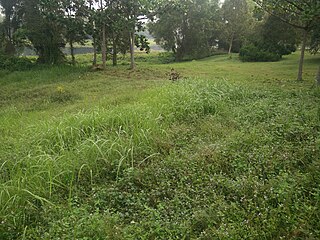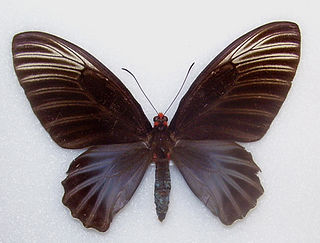
The Malay Peninsula is a peninsula in Mainland Southeast Asia. The landmass runs approximately north–south, and at its terminus, it is the southernmost point of the Asian continental mainland. The area contains Peninsular Malaysia, Southern Thailand, and the southernmost tip of Myanmar (Kawthaung). The island country of Singapore also has historical and cultural ties with the region. The indigenous people of the peninsula are Orang Asli and Malays, an Austronesian people.

Tapirs are large, herbivorous mammals belonging to the family Tapiridae. They are similar in shape to a pig, with a short, prehensile nose trunk. Tapirs inhabit jungle and forest regions of South and Central America and Southeast Asia. They are one of three extant branches of Perissodactyla, alongside equines and rhinoceroses. Only a single genus, Tapirus, is currently extant. Tapirs migrated into South America during the Pleistocene epoch from North America after the formation of the Isthmus of Panama as part of the Great American Interchange. Tapirs were formerly present across North America, but became extinct in the region at the end of the Late Pleistocene, around 12,000 years ago.

The South American tapir, also commonly called the Brazilian tapir, the Amazonian tapir, the maned tapir, the lowland tapir, anta, and la sachavaca, is one of the four recognized species in the tapir family. It is the largest surviving native terrestrial mammal in the Amazon.

Taman Negara is a national park in Peninsular Malaysia. It was established in 1938/1939 as the King George V National Park after Theodore Hubback lobbied the sultans of Pahang, Terengganu and Kelantan to set aside a piece of land that covers the three states for the creation of a protected area. It was renamed Taman Negara after independence, which means "national park" in Malay. Taman Negara has a total area of 4,343 km2 and it is one of the world's oldest deciduous rainforests, estimated to be more than 130 million years old.

Tapirus is a genus of tapir which contains the living tapir species. The Malayan tapir is usually included in Tapirus as well, although some authorities have moved it into its own genus, Acrocodia.

The mountain tapir, also known as the Andean tapir or woolly tapir is the smallest of the four widely recognized species of tapir. It is the only one to live outside of tropical rainforests in the wild. It is most easily distinguished from other tapirs by its thick woolly coat and white lips.

The Baird's tapir, also known as the Central American tapir, is a species of tapir native to Mexico, Central America, and northwestern South America. It is the largest of the three species of tapir native to the Americas, as well as the largest native land mammal in both Central and South America.

The Malayan civet, also known as the Malay civet and Oriental civet, is a viverrid native to the Malay Peninsula and the islands of Sumatra, Bangka, Borneo, the Riau Archipelago, and the Philippines. It is listed as "Least Concern" by IUCN as it is a relatively widely distributed, appears to be tolerant of degraded habitats, and occurs in a number of protected areas.
Malaysian Wildlife Law consists of the regulation, protection, conservation and management of wildlife in Malaysia. The Constitution of Malaysia empowers those at the federal and the states level to make laws regarding wildlife resources. As such, eleven states in peninsular are managed under an act while Sabah enacted an enactment and Sarawak an ordinance.

Tengku Hassanal Wildlife Reserve is one of the largest wildlife reserves in Peninsular Malaysia covering 605.52 km2 located in the Titiwangsa Mountains, central state of Pahang, Malaysia that was established during the British Colonial Administration. It was officially gazetted to protect all wildlife species, particularly the gaur. The administrative offices of the Reserve are located in several places. The main office is located in Bukit Rengit, and the other stations are in Lembah Klau, Kuala Lompat, and Perlok.

Malaysian Nature Society is the oldest and one of the most prominent environmental not for profit, non-governmental organisations in Malaysia. It was first established, as the Malayan Nature Society, with the launch of the Malayan Nature Journal, in 1940. Initially primarily as a scientific organisation, today MNS is involved in a wide range of environmental activities and campaigns. In 2008 MNS was awarded the inaugural Merdeka Award for the environment, primarily for its efforts in campaigning for the protection of the Belum-Temengor forests of Malaysia. MNS is a voluntary, membership-based organisation with approximately 3800 members.

The Peninsular Malaysian peat swamp forests is an ecoregion on Malay Peninsula, which includes portions of Malaysia. It is in the tropical and subtropical moist broadleaf forests biome.

Atrophaneura nox, the Malayan batwing, is a papilionid butterfly found in Java, northern Borneo and Peninsular Malaysia.

The wildlife of Malaysia is diverse, with Malaysia being a megadiverse country. Most of the country is covered in rainforest, which hosts a huge diversity of plant and animal species. There are approximately 361 mammal species, 694 bird species, 250 reptile species, and 150 frog species found in Malaysia. Its large marine territory also holds a great diversity of life, with the country's coastal waters comprising part of the Coral Triangle.

The Malayan weasel or Malay weasel is a weasel species native to the Malay Peninsula and the islands of Sumatra and Borneo. It is listed as Least Concern on the IUCN Red List.

The Peninsular Malaysian rain forests is an ecoregion on Malay Peninsula and adjacent islands. It is in the tropical and subtropical moist broadleaf forests biome.

The Peninsular Malaysian montane rain forests is an ecoregion on Malay Peninsula. It occupies the mountainous spine of the peninsula in Malaysia and southernmost Thailand. It is in the tropical and subtropical moist broadleaf forests biome.

The Sumatran lowland rain forests ecoregion covers the lowland forests running the length of the island of Sumatra in Indonesia. The region is one of exceptionally high biodiversity, similar to Borneo and New Guinea islands. Many endangered mammals species are present, and over 450 species of birds have been found in the region. In recent years, illegal logging and human encroachment have put great strain on this ecoregion.
Taman Negeri Rompin or Rompin State Park is located within Rompin District, Pahang, Taman Negeri Rompin Pahang (TNRP) spans an area of 31,797 hectares, consisting of lowland mixed dipterocarp forest, edaphic hill forest formation and rivers. The geological history of the park dates back at least 248 million years to the Permian-Carboniferous age, which the rock types include low grade metamorphics, igneous, granite and sedimentary sequence that has shaped the ecosystem within the protected area.























